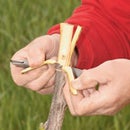Introduction: How to Build Your Own Fire Pit
There are few things as relaxing as a warm fire on a cool evening. An outdoor fire pit makes any patio or backyard into a great gathering place where friends and family can eat, talk, or just rest by the fire.
While you can build a fire pit from rock or have one poured, this fantastic do-it-yourself version from the folks at Progressive Farmer magazine uses bricks or cinder blocks and offers clear step-by-step instructions and a materials list to help make your project both fun and easy.
The installation is pretty quick — you can build a fire pit in just one day — and doesn’t cost a whole lot, especially if you look for a sale on bricks at the end of the season at Lowe’s or Home Depot. You can even occasionally find bricks for free when someone tears down a structure or replaces their driveway.
Step 1: Preparation
STONES We built this fire pit from landscaping blocks. You can use field stone or other materials too. Do not use stones that have been submerged in water; they can explode with the heat of the fire. Concrete blocks may deteriorate from the heat, but they are cheap to replace.
DRAINAGE In the bottom center of the pit, we dug a fencepost-sized hole 2 feet deep and filled it with gravel. The hole works like a sump, helping to drain rainwater.
ADHESIVES We dry-stacked the stone. It's a quicker way to build the fire pit. If you have to replace cracked or broken stones, dry-stacking makes that job easier as well. If you want to cement the courses, lay cement down only on the outside half of the stones to protect the cement from the heat. Adhesives may melt and give off fumes; we advise against using them.
SAFETY This fire pit is built in a wooded area. Before we started the fire, we soaked the area around the pit with water. We also had 5-gallon buckets of water and a shovel handy to put out any stray fires.
What You'll Need
98 retaining wall blocks
steel pit ring with tabs
metal grate
sand
gravel
We bought the ring and grate as specialty items from a garden store. We couldn't find a place to order these pieces from on the Internet, so we'd suggest welding your own or having them produced at a welding shop.
The retaining wall blocks used in this project were 12 inches wide, 4 inches high and 8 inches deep.
We purchased about one-half ton each of sand and gravel.
Total Cost: about $500
Step 2: Dig a Hole
We dug a hole 2 feet wider than the fire pit--about 7 feet across. Make the hole round by hammering a stake into the center of your fire pit area. Loop a 3 1/2-inch length of string over the stake and mark the circle. Dig out 12 inches of soil. Shovel in 4 inches of gravel and 4 inches of sand. Tamp that layer flat. Onto that base, lay down the base course of blocks. Make sure this course is level in all directions. Fill the space outside of the blocks with gravel. This nearly buries the first course, making the stone base strong.
Step 3: Lay the Courses of Stone
Lay additional courses of stone. We used the steel ring that will hold the grill in place to ensure each course is round and of the correct diameter. We purchased the ring from a garden supply store. To keep the courses perpendicular to each other and level to the ground, hang a piece of string over the edge of the top-most course. When each course touches this string--and the string is touching the base course--all the courses are roughly perpendicular. The middle of our pit was 32 inches in diameter.
Step 4: Stack Additional Layers
Use a brush to clean debris from the surface of the previous layer. Overlap the layers of stone, leaving three or four random gaps between stones in every course. The gaps allow the fire to draw air into itself. We dry-stacked the stone. They may get out of alignment, but realignment is easy. We learned something the hard way: put gravel into the center of the fire pit after you've stacked a couple of courses. Then spread it evenly when you're finished. We shoveled the gravel into the pit after it was completed and found lifting the gravel that high was unnecessary work.
Step 5: Steel Ring
Before you lay the final course of stone, set the steel ring in place. Then add the final layer of stone onto the lip of the ring. As originally built, the fire pit was seven layers tall--each layer took 14 stones--and about 25 inches tall. But we have found that the fires burn even better once we removed one layer of stone.
Step 6: Video
Our detailed video demonstrates the making of this easy DIY project from start to finish.










